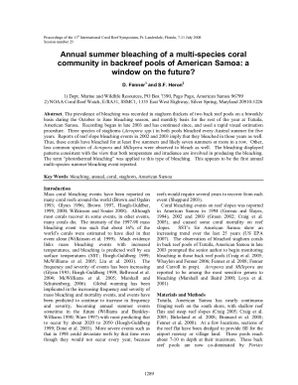Annual summer bleaching of a multi-species coral community in backreef pools of American Samoa: a window on the future?
- Description:
- The prevalence of bleaching was recorded in staghorn thickets of two back reef pools on a biweekly basis during the October to June bleaching season, and monthly basis for the rest of the year at Tutuila, American Samoa. Recording began in late 2003 and has continued since, and used a rapid visual estimation procedure. Three species of staghorns (Acropora spp.) in both pools bleached every Austral summer for five years. Reports of reef slope bleaching events in 2002 and 2003 imply that they bleached in those years as well. Thus, these corals have bleached for at least five summers and likely seven summers or more in a row. Other, less common species of Acropora and Millepora were observed to bleach as well. The bleaching displayed patterns consistent with the view that both temperature and irradiance are involved in producing the bleaching. The term photothermal bleaching was applied to this type of bleaching. This appears to be the first annual multi-species summer bleaching event reported.
- Display date:
- 2008
- Collections:
- Secretariat of the Pacific Regional Environment Programme (SPREP)
- Publisher:
- Department of Wildlife Resources
- Content partner:
- Secretariat of the Pacific Regional Environment Programme (SPREP)
- Availability:
- Not specified
-
Copyright status: All rights reservedFind out more about what you are able to do with this itemThis item is all rights reserved, with means you'll have to get permission from Secretariat of the Pacific Regional Environment Programme (SPREP) before using it. For more information, please see our use and reuse page.What can I do with this item?Non-infringing useNZ copyright law does not prevent every use of a copyright work, and this item may be hosted by an international institute or organisation. You should consider what you can and cannot do with a copyright work.No sharingYou may not copy and/or share this item with others without further permission. This includes posting it on your blog, using it in a presentation, or any other public use.No modifyingYou are not allowed to adapt or remix this item into any other works.No commercial useYou may not use this item commercially.
Related items
Welcome and warm Pasifik greetings
The information on this site has been gathered from our content partners.
The names, terms, and labels that we present on the site may contain images or voices of deceased persons and may also reflect the bias, norms, and perspective of the period of time in which they were created. We accept that these may not be appropriate today.
If you have any concerns or questions about an item, please contact us.
